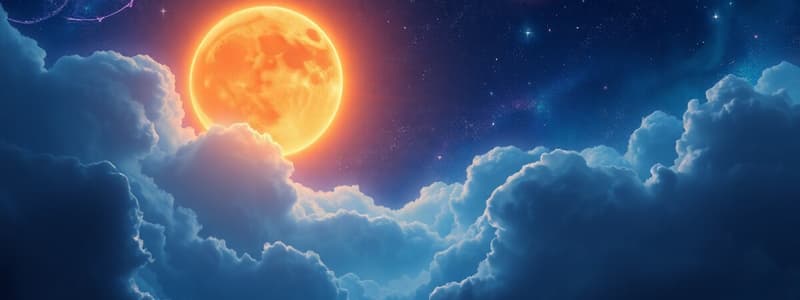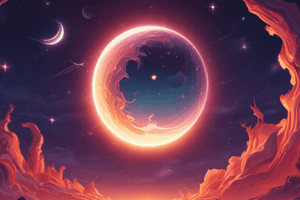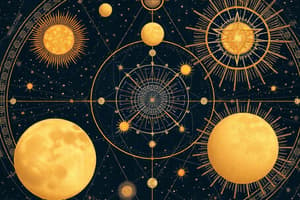Podcast
Questions and Answers
Which of the following celestial bodies does NOT produce its own light?
Which of the following celestial bodies does NOT produce its own light?
- The Sun
- A Star
- The Moon (correct)
- All of the above
The Sun appears larger and brighter than other stars because it is farther away from Earth.
The Sun appears larger and brighter than other stars because it is farther away from Earth.
False (B)
What is the layer of air surrounding the Earth called?
What is the layer of air surrounding the Earth called?
atmosphere
Large areas of flat land are called ______.
Large areas of flat land are called ______.
Match the following landforms with their descriptions:
Match the following landforms with their descriptions:
What is the primary reason we cannot see other stars during the daytime?
What is the primary reason we cannot see other stars during the daytime?
¿Como se dice 'the sun' en español?
¿Como se dice 'the sun' en español?
Imagine the Earth's atmosphere vanished instantly. Which of the following would NOT be an immediate consequence?
Imagine the Earth's atmosphere vanished instantly. Which of the following would NOT be an immediate consequence?
Flashcards
Stars
Stars
Huge balls of hot, burning gases that give out heat and light.
The Sun
The Sun
The star closest to Earth, providing heat and light.
The Moon
The Moon
A big ball of rock that moves around the Earth.
The Earth
The Earth
Signup and view all the flashcards
Oceans and Seas
Oceans and Seas
Signup and view all the flashcards
Plains
Plains
Signup and view all the flashcards
Mountains
Mountains
Signup and view all the flashcards
Atmosphere
Atmosphere
Signup and view all the flashcards
Study Notes
- We live on Earth and see the sky when we look up, including clouds, lightning, rainbows, the Sun, Moon, and stars.
Stars and the Sun
- Stars are massive, hot, burning gas balls that emit heat and light.
- Stars appear small due to their immense distance from Earth.
- The Sun is a star and is the closest one to Earth.
- The Sun appears bigger and brighter than other stars due to its proximity.
- Sunlight is much brighter, making other stars invisible during the day.
- Earth revolves around the Sun.
- The Sun provides heat and light to Earth.
- Plants require sunlight to produce food.
- Without the Sun's heat and light, life on Earth would not exist.
The Moon
- The Moon is a substantial rock ball orbiting Earth.
- It is Earth's closest neighbor in space, closer than the Sun.
- The Moon does not produce its own light.
- The Moon reflects sunlight, which is why it appears to shine.
The Earth
- Earth is the home to humans, plants, animals, and insects.
- Earth is a planet, a large, round object orbiting the Sun.
- Like the Moon, Earth is a rock ball, with a surface of water and land.
Oceans and Seas
- Oceans and seas are vast bodies of water covering most of Earth.
- Seas are smaller than oceans.
Land
- Land covers a small portion of Earth but is essential for life.
- Land is where we live, grow food, and build infrastructure.
- Land consists of various natural features or landforms.
- Plains are large, flat areas of land where many people live and grow crops like rice and wheat.
- Mountains are elevated highlands that rise above the plains.
- Hills are also highlands, but are smaller than mountains.
- A valley is a lowland area situated between two hills or mountains.
Atmosphere
- The atmosphere is a layer of air that surrounds Earth.
- The atmosphere is crucial for life.
- Air is essential for breathing.
- The atmosphere regulates Earth's temperature, preventing extreme hot or cold conditions.
Studying That Suits You
Use AI to generate personalized quizzes and flashcards to suit your learning preferences.




